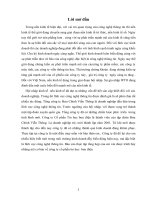Metamorphic petrology lecture v
Bạn đang xem bản rút gọn của tài liệu. Xem và tải ngay bản đầy đủ của tài liệu tại đây (4.55 MB, 27 trang )
Lecture FIVE
Metamorphic Textures
Metamorphic fabric and textures
Again,
Again Identification of a given metamorphic rock depend on:
1- Mineral composition
2- Texture
Metamorphic rocks undergo deformation
crystallization as a result of pressure influence.
during
their
Orogeny is described to long-term mountain-building e.g:
Pan African Orogeny. The orogeny may:
comprise several Tectonic Events
have several Deformational Phases
have an accompanying Metamorphic Cycles with one or
more Reaction Events
Tectonite is a deformed rock with a texture that records the
deformation
Metamorphic fabric and textures
Metamorphic fabric and textures
Texture (grain-grain relationships) refer to:
1) shape and size of the individual grains
2) orientation of the individual grains
3) arrangements of the mineral grains in metamorphic rock
structure used for large features
Fabric refer to the complete spatial and
configuration of textural and structural elements
geometric
Importance of textures in metamorphic rocks to:
1) decipher the order of crystallization of minerals,
2) sequence of events involved in forming the metamorphic
rocks,
3) Intensity of P-T condition during metamorphism, and
4) used to nominate the metamorphic rocks
A- Grain size
Remember that, the grain size of a given metamorphic rocks
is function of:
Intensity of P-T conditions
- Very low conditions very low grain size texture
- Very high conditions very coarse-grained texture
rate of nucleation (high rate donate finer grain sizes)
Subsequent time internal (shorter time donate more finer
grain size)
A- Grain size Categories
Metamorphic rocks have different
sizes:
- Fine-grained (<0.75 mm)
- Medium grained (0.75-1.0 mm)
- Coarse grained (1-2 mm)
- Very coarse grained (>2 mm)
B- Textures donating planar or linear elements:
These textures described in metamorphic rocks that
composed of unequal mineral assemblage with preferred
orientation. They include:
Foliation- planar textural elements
Lineation- linear textural elements
- Rocks without preferred orientation massive or isotropic
Massive/isotropic
Foliation
Lineation
1- Foliation Types
Foliation: defined by any layering
in a metamorphic rock as a result of
parallel arrangement or distribution of
planar elements that include:
I- Compositional layering: defined by
alternating
layers
composed
of
different mineral composition and/or
different
grain
sizes.
Easily
recognized by differences in color of
layers.
1- Foliation (Cont.)
II-
Gneissosity:
defined
by
compositional layering of equent
crystals
(e.g. quartz, feldspars)
alternate with platy or elongate
mineral layes (e.g. micas). It is
usually coarse-grained size.
1- Foliation (Cont.)
IIISchistosity:
defined
by
alignment of play (mica, chlorite) or
inequent
(amphiboles,
quarz)
minerals
- Minerals defining schistosity are
said to posses preferred orientation
and usually are medium-grained.
1- Foliation (Cont.)
IVCleavage:
Schistosity
surface along which the rock
may break (cleave). It include:
a- Slaty cleavage in very finegrained mica and/or chlorite in
slate and phyllite,
bCrenulation
cleavage:
alignments with cm- to mmscale periodic folding
1- Foliation (Cont.)
V- Mylonite layering: defined by layers of highly strained rock
with elongated grains due to grain size reduction and dynamic
recrystalization during shearing
2- Lineation
Lineation: parallelism or alignment
of linear elements in the rock
Types of lineations:
a. Preferred orientation of
elongated mineral aggregates
(e.g. quartz pebbles in
metaconglomerates)
b. Preferred orientation of elongate
minerals (feldspars & Hb)
c. Lineation defined by platy
minerals
d. Fold axes (especially of
crenulations)
e. Intersecting planar elements.
Foliation and Lineation
C- Textures donating lake of preferred orientation or
equigranular grains:
- Hornfelsic textures: random orientation of fine-grained rocks,
due to lack of stresses, granofelsic texture for the medium to
coarse grained rock
C- Textures donating lake of preferred orientation or
equigranular grains (Cont.)
- Granoblastic texture: A mosic of fine to coarse grained
anhedral grains, such as marble and granulites
D- Textures donating Large grains within the rock:
-Porphyroblastic texture: A relatively
large crystal (e.g. garnet, staurolite) in
smaller fine grained matrix. It could be
-Idioblast (Euhedral),
-subidioblast (subhedral) or,
- xenoblast (anedral).
D- Textures donating Large grains within the rock:
-Porphroclastic texture: A large
strained or bracken grain in fine
grained matrix
-Blastoporphyritic texture: A relict
of porphyritic volcanic texture in
metamorphic rocks
- Augen texture: Porphyroblast of
feldspars with eye-shape cross
section in fine grained gneissic
matrix
E- Textures donating inclusion within or rim on a
porphyroblasts:
- Poikiloblastic or sieve texture:
porphyroblast
containing
numerous inclusions of one or
more fine grains.
E- Textures donating inclusion within or rim on a
porphyroblast:
Corona or reaction rim:
A zone
consisting of grains of a new
minerals that have formed at rim
around mineral.
Corona texture









